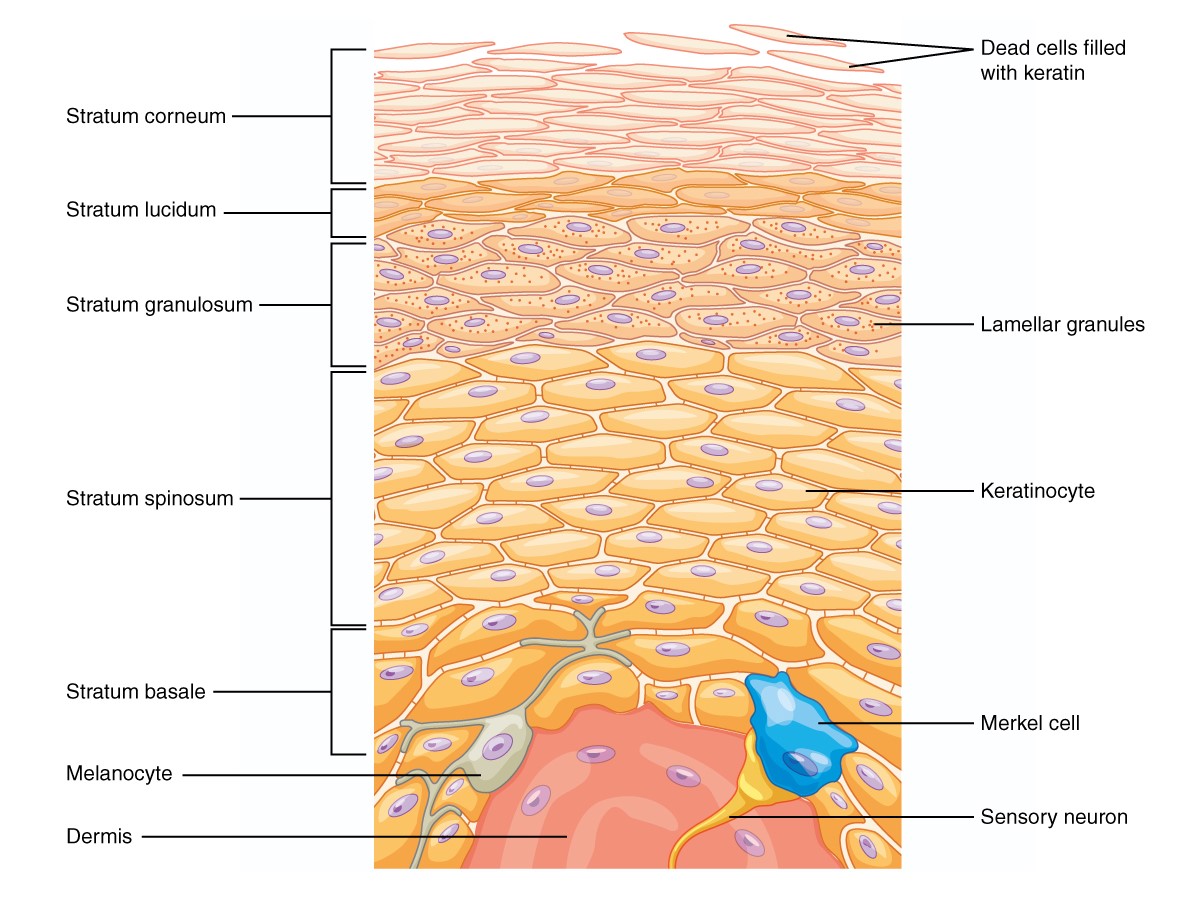Playlist
Show Playlist
Hide Playlist
Epidermis: Cells and Layers
-
Slides Epidermis Cells and Layers.pdf
-
Download Lecture Overview
00:01 Now we're going to focus on the epidermis, which is the upper layer of the skin. 00:06 It is derived from the ectoderm germ layer. 00:10 It is indeed the outer layer of the skin. 00:13 And it's defined as stratified squamous epithelium. 00:17 Stratified means there's different layers. 00:19 And squamous is referring to the type of cells that we see in the epithelium. 00:24 The epidermis is totally avascular meaning that there's no blood vessels. 00:30 And it depends on the underlying dermis for nutrient delivery and waste disposal. 00:37 Now let's look at the epidermis. 00:39 Just zoning on the epidermis. 00:41 And look at the types of cells that we see within the epidermis. 00:45 Ap the upper layer. 00:46 There are four different cell types. 00:48 Within the epidermis. 00:49 There's keratinocytes which make the major composition of the of the epidermis. 00:54 That is 95% of the cells are keratinocytes. 00:57 And then we have melanocytes which produce melanin. 01:01 And we've got merkel cells and Langerhans cells. 01:04 We're going to talk about each of these cells in my discussion later. 01:07 So we are now zoning in on the keratinocytes. 01:12 These are keratinocytes as I mentioned. 01:14 They make 95% of the epidermis. 01:18 The majority of the cells that we see and they are rich with keratin hence the name keratinocytes. It means they are full of keratin. 01:27 They are stacked in layers of increasingly mature states. 01:31 That's why we also call them stratified. 01:34 It's layers of keratinocytes. 01:39 Now we're moving on to the second cell which is called melanocytes the melanocytes. 01:45 These are pigment production cells that we find in the basal layer of the epidermis. 01:55 The third cell type is the merkel cell which you also find in the epidermis. 01:59 What does it do? It acts as a A kind of receptor, and it's part of the basal layer, which is a lower layer of the epidermis. 02:08 It is associated with dermal nerve fibers. 02:11 And these are the cells that help us to feel and touch. 02:17 The last cell that I'm going to talk about. 02:19 Within the epidermis are the Langerhans cells. 02:22 Langerhans cells. 02:24 These are derived from the bone marrow. 02:26 And they are important in the immunological function of the skin. 02:33 They act as surveillance, checking the viruses, the bacteria and infection that's coming to invade the skin right now. 02:43 Let's move on to the layers of the epidermis. 02:46 We spoke about the different layers of the skin. 02:49 We covered the different types of the cells that we see in the epidermis. 02:54 Now we're moving on to the layers of the skin that is the epidermis. 02:59 We've got the stratum basale, meaning the basal layer, the stratum spinosum because you've got spinal cells in this area. 03:08 We also have thirdly the stratum granulosum because we've got this layer that's got granules. Hence stratum granulosum. 03:15 And then stratum lucidum is the clear layer of the epidermis. 03:19 And lastly the upper layer which is the stratum corneum because it's got cells called corneocytes. Now let's zoom in on the stratum basale or germinative layer. 03:32 It's one row of cuboidal cells that is attached to the basement membrane of the skin, and the basement membrane separates the epidermis and the dermis. 03:41 And you can see the stratum basale. 03:45 The second layer is the stratum spinosum or the squamous layer, the squamous layer. 03:50 Because it contains the squamous cells, it is the thickest layer with irregular polyhedral keratinocytes. 03:58 And you can see those cells, you know, dispersed along the epidermis. 04:04 The third layer is the stratum granulosum granulosum granular layer. 04:10 Why? Because it is characterized by the presence of granules within the cytoplasm of keratohyalin granules, and that gives it the name stratum granulosum. 04:23 The fourth layer is the stratum lucidum, as I mentioned. 04:26 Lucidum means clear cell layer. 04:29 This is a thin layer of anuclear cells, meaning they do not have any nucleus, and the whole cytoplasm is packed with keratin and it can only be seen in the thicker skin, that is, the palms and the soles. 04:44 These are the only areas in the skin where you have the stratum lucidum, and you can imagine it's thick. 04:50 We use our hands. We use our feet. 04:51 We need that functional functionality. 04:55 And then the stratum corneum is the horny layer of the skin. 04:59 It is the most superficial layer and is composed of dead anucleated flattened Keratinocytes or squames that are being sloughed from the surface when your skin scales or peels off. 05:13 This is a layer that is actually being removed by the normal physiology of the skin. 05:20 Okay. Now let's see what happens when there's a disorder of some of these cells that we've spoken about. 05:28 We spoke about the basal layer. 05:30 So we start from the basal layer. 05:32 When we have an abnormality in the stratum basale, you get a condition called basal cell carcinoma, as the name says, basal cell carcinoma. 05:42 And this cancer tends to occur in white patients and people with albinism because of changes that are induced by ultraviolet rays. 05:54 In black people, it is called pigmented basal cell carcinoma. 05:59 Because of the pigment that we find in patients with dark skin. 06:03 We will talk about this later on and explain how that happens. 06:07 We also spoke about the stratum spinosum, and what happens when you've got a problem with the stratum spinosum cells. 06:14 We get a condition called squamous cell carcinoma. 06:17 And as the name says these are squamous. 06:20 I mentioned that to you. Squamous cells. 06:22 So if you have a defect or a problem then you have squamous cell carcinoma. 06:28 And this we see again mainly in people with less pigment that is the white patients or Caucasian patients as well as patients with albinism because they lack melanin. 06:40 Stratum corneum also spoke about that as one of the layers. 06:43 And when there's a defect in the stratum corneum, which is responsible for making sure of thermoregulation and the skin barrier of the skin, we get a condition called atopic eczema because this area is defective. 06:59 And of course, there are other causes that are implicated, like genetic types as well as lipids.
About the Lecture
The lecture Epidermis: Cells and Layers by Ncoza Dlova is from the course Introduction to Dermatology.
Included Quiz Questions
Which epithelial classification best describes the histological structure of the epidermis?
- Stratified squamous epithelium
- Stratified columnar epithelium
- Simple columnar epithelium
- Simple squamous epithelium
- Pseudostratified epithelium
Which type of cells constitutes the majority of the epidermis?
- Keratinocytes
- Adipocytes
- Stem cells
- Capillaries
- Mesodermal cells
What is the most superficial layer of the epidermis?
- Stratum corneum
- Stratum basale
- Stratum spinosum
- Stratum granulosum
- Stratum lucidum
Customer reviews
5,0 of 5 stars
| 5 Stars |
|
5 |
| 4 Stars |
|
0 |
| 3 Stars |
|
0 |
| 2 Stars |
|
0 |
| 1 Star |
|
0 |




